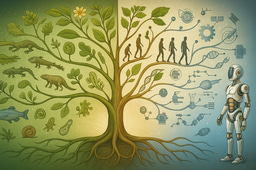The Global South as the Epicenter of the Next Wave of Endemic Innovation
Published in Social Sciences, Business & Management, and Economics

What do Panama’s Geisha coffee, Bolivia’s royal quinoa, and solar-powered refrigeration in India’s Thar Desert have in common? They are not just local success stories. They are examples of Endemic Innovation: solutions born from specific and often unreplicable conditions, offering value precisely because of their uniqueness.
As countries across the Global South search for viable and sustainable development paths, the answer may lie not in what they lack — but in what they already have.
Innovating from within
In most global innovation rankings —like the Global Innovation Index 2025 by WIPO— the Global South appears to lag behind. But what if the problem is not innovation itself, but the metrics we use to measure it?
Some of the world’s most impactful solutions don’t come from high-tech labs or billion-dollar startups. They emerge from people solving problems with what’s available — sometimes with ancestral knowledge, other times with low-cost, high-ingenuity approaches.
I refer to this as Endemic Innovation: “the process of developing sustainable solutions that are unique and exclusive to a specific region of the world, explained by singularities in its geography, climate, culture, history, institutions or technologies.” These innovations are not behind — they are simply playing a different game, one grounded in context, resilience, and creativity.
Innovation capabilities meet complexity economics
In 2024, WIPO published its World Intellectual Property Report, highlighting how innovation capabilities are often misaligned with policy design.
One key insight? Countries must understand their Economic Complexity —a measure of the productive knowledge embedded in what they produce and export (Hidalgo and Hausmann, 2009). Nations with more complex economies like Singapore in the Fig. 1, are those that can produce a greater variety of more sophisticated and less ubiquitous products.
%2012.59.44.png)
Fig. 1 Economic Complexity Index among different selected countries, from 1995 to 2023.
But complexity is not just about tech. It’s about know-how, especially when it’s distributed across communities, industries, and ecosystems. In fact, the report urges policymakers to focus on building capabilities from existing strengths — instead of trying to imitate foreign models.
This aligns perfectly with the logic of Endemic Innovation: don’t start by asking what’s missing; ask what’s already working and what we already have, and how it can evolve.
In many emerging economies, the traditional path to development—based on replicating industrial models from the Global North—has reached diminishing returns. A promising alternative lies in leveraging local singularities—natural, cultural, ecological, and social—to generate context-specific solutions. These endemic innovations, though born of place-based conditions, can reach high levels of sophistication and low ubiquity, characteristics that are central to improving a country's economic complexity.
Economic complexity, a measure of the diversity and uniqueness of a country's productive capabilities, is a strong predictor of long-term growth. Yet, many economies in the Global South have stagnated or even declined in their complexity rankings. Take the case of Chile, which dropped from 75th to 88th in global economic complexity between 2000 and 2023.
%2012.48.34.png)
Fig. 2 Economic Complexity Index of Chile, from 2000 (75) to 2023 (88).
This decline reflects a limited expansion of capabilities and underscores the need for new strategies. By activating underutilized territorial assets and capacities, endemic innovation offers an operational model to diversify economies from within—enabling countries to move into more complex and high-value production pathways rooted in their own ecosystems.
Geographical Indications: legal tools for singular value
One powerful and underused tool to support Endemic Innovation is the Geographical Indication (GI). A GI legally protects a product whose quality, reputation or characteristics are essentially linked to its place of origin.
Think of Roquefort cheese, Darjeeling tea, or Colombian coffee. These products aren’t just commodities — they are embedded in place-based know-how and collective heritage.
For Global South countries, GIs are more than just labels: they are a way to translate singularity into competitive advantage, to turn local ecosystems into globally recognized brands, and to protect endogenous value creation.
They are also a way to give legal and market power to farmers, artisans, and communities — not just tech entrepreneurs or multinational firms.
From dependency to design
Recent reports like WIPO’s show that innovation doesn’t emerge from nowhere — it emerges from capability, context, and long-term investment in knowledge systems. For Global South countries, this means shifting the development question from “How do we catch up?” to “What can only we do?”.
Endemic Innovation, supported by a deep understanding of economic complexity and empowered by tools like Geographical Indications, offers a future-oriented strategy — not one based on imitation, but on differentiation.
So here’s the real development question for the Global South:
What innovation could only have been born here, under your specific conditions?
That’s where your next advantage lies and your next policy should begin.
References:
-
Hidalgo, C., Hausmann, R. (2009) The Building Blocks of Economic Complexity, Proceedings of the National Academy of Sciences (PNAS), Vol. 106, No. 26, Jun 30, 2009.
-
Martínez Pereira, D. (2023). What is—and what isn’t—Endemic Innovation?
-
WIPO (2025). Global Innovation Index 2025 – Innovation at a Crossroads
-
WIPO (2024). World Intellectual Property Report – Innovation Capabilities and Industrial Policy
-
WIPO (2024). The Complexity Concept in Policy Design
-
WIPO – Geographical Indications





Please sign in or register for FREE
If you are a registered user on Research Communities by Springer Nature, please sign in